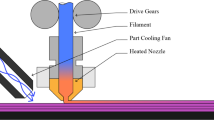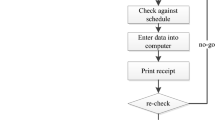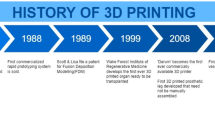Abstract
The nesting problem in the textile industry is the problem of placing a set of irregularly shaped pieces (calledstencils) on a rectangularsurface, such that no stencils overlap and that thetrim loss produced when cutting out the stencils is minimized. Certain constraints may put restrictions on the positions and orientation of some stencils in the layout but, in general, the problem is unconstrained. In this paper, an algorithmic approach using simulated annealing is presented covering a wide variety of constraints which may occur in the industrial manufacturing process. The algorithm has high performance, is quite simple to use, is extensible with respect to the set of constraints to be met, and is easy to implement.
Similar content being viewed by others
References
M. Adamowicz and A. Albano, Nesting two-dimensional shapes in rectangular modules, Comp. Aided Des. 8(1976)27–33.
A. Albano and G. Sapuppo, Optimal allocation of two-dimensional irregular shapes using heuristic search methods, IEEE Trans. Syst., Man, Cybern. 10(1980)242–248.
M. Ben-Bassat and D. Dori, Efficient nesting of congruent convex figures, Commun. ACM 27(1984)228–235.
J. Chung, D.J. Hillman and D. Scott, An intelligent nesting system on 2-D highly irregular resources, in:Applications of Artificial Intelligence VIII — Proc. 8th Int. Conf. of the International Society for Optical Engineering (SPIE) (1990), Vol. 1293, pp. 472–483.
E. Coffman, M. Gary and D. Johnson, Approximation algorithms for bin-packing — an updated survey, in:Algorithm Design for Computer System Design, ed. P.S.G. Ausiello and M. Lucertini (Springer, 1984) pp. 49–106.
E. Coffman and P. Shor, Average-case analysis of cutting and packing in two dimensions, Euro. J. Oper. Res. (EJOR) 44(1990)134–144.
E. Coffman and P. Shor, Packings in two dimensions: Asymptotic average-case analysis of algorithms, Algorithmica 9(1993)253–277.
J.M. Cohn, Automatic device placement for analog cells in KOAN, Ph.D. Thesis, Department of Electrical and Computer Engineering, Carnegie-Mellon University, Pittsburgh, PA (1991).
R. Cuninghame-Green, Geometry, shoemaking and the milk tray problem, New Scientist, No. 12 (1989)10–53.
C.H. Dagli and M. Tatoglu, An approach to two-dimensional cutting stock problems, Int. J. Prod. Res. 25(1987)175–190.
K. Daniels, Z. Li and V. Milenkovic, Automatic marker making, in:Proc. 3rd Canadian Conf. on Computational Geometry, ed. T. Shermer (August 1991).
K. Daniels, Z. Li and V. Milenkovic, Placement and compaction of non-convex polygons for clothing manufacture, in:Proc. 4th Canadian Conf. on Computational Geometry (August, 1992).
K. Daniels, Z. Li and V. Milenkovic, Automatic marker making, Progress Report, Center for Reseach in Computing Technology, Harvard University, Cambridge, MA (January 1993).
K.A. Dowsland, Determining an upper bound for a class of reactangular packing problems, Comp. Oper. Res. 12(1985)201–205.
K.A. Dowsland, Some experiments with simulated annealing techniques for packing problems, Euro. J. Oper. Res. (EJOR) 68(1993)389–399.
K.A. Dowsland and W.B. Dowsland, Packing problems, Euro. J. Oper. Res. (EJOR) 56(1992)2–14.
G. Dueck, New optimization heuristics, J. Comp. Phys. 104(1993)86–92.
H. Dyckhoff and U. Finke,Cutting and Packing in Production and Distribution (Physica-Verlag, Heidelberg, 1992).
J.S. Ferreira and J.F. Oliveira, An application of simulated annealing to the nesting problem, in:ORSA/TIMS Bulletin Number 34 (Program of the 34th Joint National Meeting, San Francisco) (November 1992).
J.S. Ferreira and J.F. Oliveira, Algorithms for nesting problems, in:Applied Simulated Annealing, ed. R.V. Vidal (Springer, Berlin, 1993) pp. 255–273.
R.J. Fowler, M.S. Paterson and S.L. Tanimoto, Optimal packing and covering in the plane are NP-complete, Inf. Proc. Lett. 12(1981)133–137.
R. Haessler and P. Sweeney, Cutting stock problems and solution procedures, Euro. J. Oper. Res. (EJOR) 54(1991)141–150.
J. Heistermann, Effizientes rechnergestütztes Nesting, Ph.D. Thesis, Department of Computer Science, University of Bonn, Bonn (January 1994).
J. Heistermann and T. Lengauer, Efficient automatic part nesting on irregular and inhomogeneous surfaces, in:Proc. 4th ACM-SIAM Symp. on Discrete Algorithms (SODA '93), Austin, TX (January 1993) pp. 251–259.
J. Heistermann and T. Lengauer, The nesting problem in the leather manufacturing industry, Ann. Oper. Res. 57 (1995), this volume.
M. Huang, F. Romero and A. Sangiovanni-Vincentelli, An efficient general cooling schedule for simulated annealing,Proc. 1986 IEEE Int. Conf. on CAD (1986) pp. 381–384.
S. Hustin and A. Sangiovanni-Vincentelli, Tim, a new standard cell placement program based on the simulated annealing algorithm, unpublished.
Z. Li and V. Milenkovic, A compaction algorithm for non-convex polygons and its application, in:Proc. 9th Annual ACM Symp. on Computational Geometry (May 1993).
N. Metropolis, A. Rosenbluth, M. Rosenbluth, A. Teller and E. Teller, Equation of state calculations by fast computing machines, J. Chem. Phys. 21(1953)1097–1092.
C.E. Pfefferkorn, A heuristic problem solving design system for equipment or furniture layouts, Commun. ACM 18(1975)286–297.
W. Qu and J.L. Sanders, A nesting algorithm for irregular parts and parts affecting trim loss, Int. J. Prod. Res. 25(1987)381–397.
E. Ridenour Paternoster and P.E. Sweeney, Cutting and packing problems: A categorized application-orientated research bibliography, J. Oper. Res. Soc. 43(1992)691–706.
S. Roberts, Application of heuristic techniques to the cutting-stock problem for worktops, J. Oper. Res. Soc. 35(1984)369–377.
S. White, Concepts of scale in simulated annealing,Proc. IEEE Int. Conf. on Computer Design (1984) pp. 646–651.
Author information
Authors and Affiliations
Additional information
The work of this author was supported in part by grant Le 491/3-1 from the German Research Association (DFG).
Rights and permissions
About this article
Cite this article
Heckmann, R., Lengauer, T. A simulated annealing approach to the nesting problem in the textile manufacturing industry. Ann Oper Res 57, 103–133 (1995). https://doi.org/10.1007/BF02099693
Issue Date:
DOI: https://doi.org/10.1007/BF02099693




